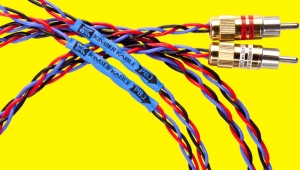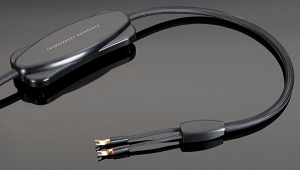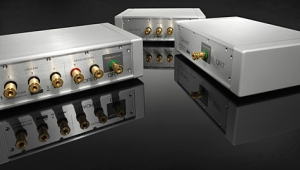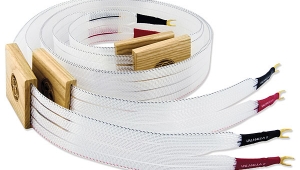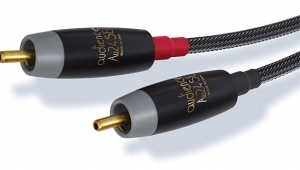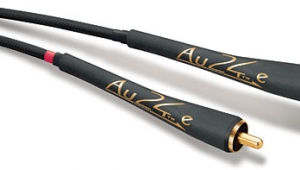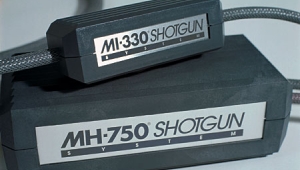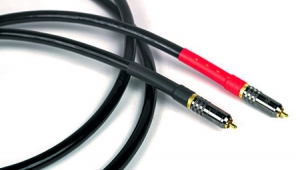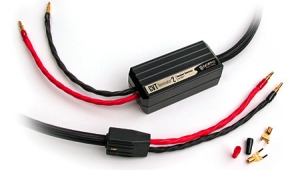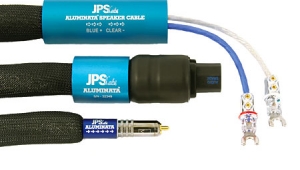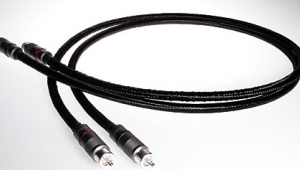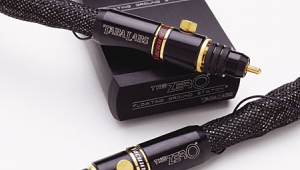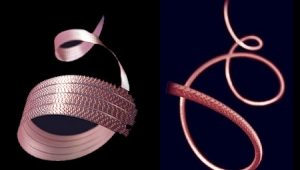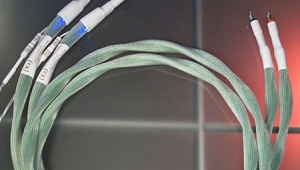| Columns Retired Columns & Blogs |
Harmonic Technology CyberLight Wave & P2A interconnects Measurements
Sidebar 3: Measurements
Stereophile doesn't routinely publish cable measurements. However, because the Harmonic Technology CyberLight Wave and P2A cables include active voltage/light and light/voltage transducers, it cannot be taken for granted that they will behave in the expected linear manner. I therefore asked Harmonic Technology to send me a balanced set of CyberLight interconnects, both for me to try out between my Mark Levinson D/A processor and preamplifier, and to be measured.
For the measurements, I hooked up the cables between the balanced outputs and inputs of my Audio Precision System One test set. The latter had its output impedance set to 50 ohms and its load impedance set to 100k ohms, these typical of the conditions the cable would see in a real-world system. The cables were powered from the supplied Cyber Power Pack battery box, which, after the recommended 18-hour charging period, was supplying a steady 12.73V DC.
My first test was to send a 1kHz tone at 1V through the cables. I expected some insertion loss, but what I did not expect was to see the voltage at the cable's outputs slowly change with time. With a 1V input to the left-channel cable, its output was initially 830mV; ie, a drop of 1.6dB. However, over the next five minutes, the level declined to 781.5mV (–2.14dB), where it stabilized. The right channel behaved slightly differently, ending up with a steady-state level 0.71dB higher at 847.9mV. In direct comparisons with conventional cables, these level differences will be audible.
The source transducer's input impedance was a moderate 6k ohms, which is on the low side for some tubed preamps and source components. These may sound lean as a result. The output transducer's source impedance varied between 1 and 2 ohms over most of the audioband, rising to 24 ohms at 20Hz. However, the absolute value depended to a slight extent on the signal level.
To my surprise, though the CyberLight's frequency response was flat in the midrange and treble, it featured a small bass boost, the exact degree of which depended on the load impedance. Peaking by 1dB below 20Hz into 100k ohms, this decreased to +0.5dB into 600 ohms (fig.1). And again note the 0.71dB channel imbalance in this graph, which was taken with a 100mV input signal. At 1V, the imbalance worsened slightly, to 0.76dB. The CyberLight's unweighted, wideband signal/noise ratio was modest, at 72.8dB (ref. 1V). Switching in an A-weighting filter improved this figure to a good 87.9dB, but this cable actually has less dynamic range than, for example, the CD medium. As MF noted, you may hear a slight hiss coming from your speakers with this cable, depending on the sensitivity of your loudspeakers.

Fig.1 Harmonic Technology CyberLight, frequency response at 100mV output into 100k ohms (top) and 600 ohms (bottom). (0.5dB/vertical div., right channel dashed.)
The measured behavior so far described concerns linear errors. How about nonlinear behavior? In its literature, Harmonic Technology claims that the "Uniformity Density Modulation" technology used in the CyberLight's Light Analog Module produces light photons in exact proportion to the number of electrons representing the analog signal. However, it cannot be taken for granted that an optical transducer will respond in a linear manner to the input stimulus. Fig.2 plots the percentage of harmonic distortion and noise present in the CyberLight's output as I changed the signal level from 10mV to 10V, with load impedances of 100k and 600 ohms. The rising trend with decreasing level below 30mV indicates that distortion products are buried beneath the cable transducers' noise floor. However, the increase in the measured percentage above 30mV into 600 ohms and 60mV into 100k ohms is due to the introduction of non-linear distortion.
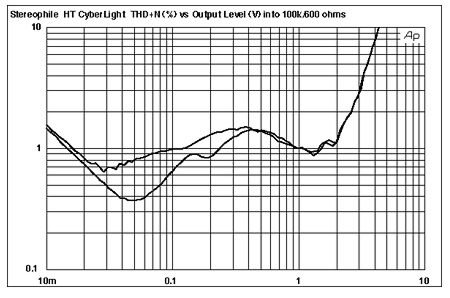
Fig.2 Harmonic Technology CyberLight, distortion (%) vs 1kHz output voltage into (from bottom to top at 100mV): 100k ohms, 600 ohms.
The change in distortion with level is complex, but there is no doubt that the cable's optical transducers both have a bent transfer function and are clipping for signal levels much above 1V RMS. This graph shows the left-channel cable's behavior; plotting both cables' THD+noise percentage against frequency (fig.3) at a moderate 100mV signal level reveals that the right-channel cable was worse in this respect.
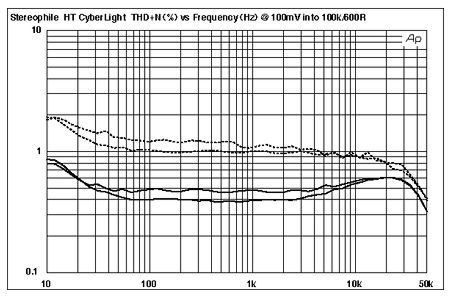
Fig.3 Harmonic Technology CyberLight, THD+N (%) vs frequency at 100mV into (from bottom to top): 100k ohms, 600 ohms (right channel dashed).
In a typical system with CD sources, the CyberLight cable will have to handle maximum voltages of up to 2V. Fig.4 shows a spectral analysis of the cables' output driving a 1kHz tone at 1V into 100k ohms. (For reference, the Audio Precision's signal generator, measured using 6' of balanced AudioQuest Cheetah, introduces just 0.0004% distortion at this level, primarily the second harmonic at –108dB.) A regular succession of distortion harmonics can be seen in fig.4, though the fact that their amplitudes decrease with increasing order might make the distortion's sonic signature more acceptable. A similar picture can be seen at lower levels (fig.5), where the limited dynamic range can be seen, and with intermodulation distortion (fig.6).The distortion introduced by the CyberLight cables never drops below the level where it will be inaudible, in my opinion.
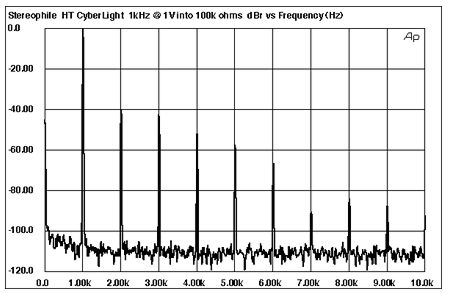
Fig.4 Harmonic Technology CyberLight, spectrum of 1kHz sinewave, DC–10kHz, at 1V into 100k ohms (linear frequency scale).
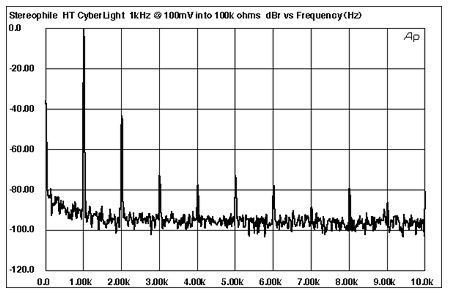
Fig.5 Harmonic Technology CyberLight, spectrum of 1kHz sinewave, DC–1kHz, at 100mV into 100k ohms (linear frequency scale).
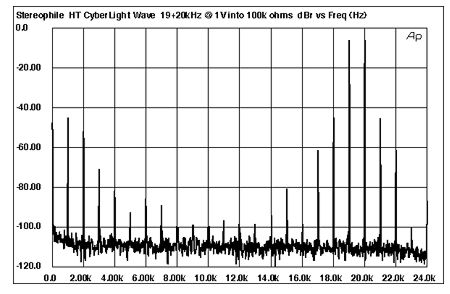
Fig.6 Harmonic Technology CyberLight, HF intermodulation spectrum, DC–24kHz, 19+20kHz at 1V into 100k ohms (linear frequency scale).
Following the measurements, I spent some time auditioning the CyberLight cables both in my system and in Michael Fremer's. Even with me knowing how they measured, the cables surprised me with the general acceptability of their sound. There was a coherence to the stereo image, a nice three-dimensionality to the sonic objects within the soundstage, and a vivid overall presentation. Against those, there was a "hummy" quality to the sound of bass guitar, with the tonal emphasis shifted away from the fundamental to the harmonics, and closely miked voices, such as Willie Nelson's on "Stardust," took on a bit of a bark. Dynamics seemed exaggerated, with climaxes sounding louder than I was expecting. In the long term, I found the CyberLight's presentation rather relentless.
I think that what the listener perceives with this cable is that at low levels, the sound is fattened and made more coherent-sounding by the dominant second-harmonic distortion. In addition, the presence of background noise cannot be dismissed, as there is some evidence that introducing small amounts of random noise results in a sound that is preferred by listeners. At higher signal levels, transients are accompanied by bursts of higher harmonics. However, these subside as quickly as they appeared. The overall effect is to render the system sound as being more vivid, I believe. However, the inevitable intermodulation products that are generated by the cable's bent transfer function leads, I conjecture, to the relentless quality I noted in my own auditioning.
If this review were of a conventional product, I would dismiss it as being broken. Ultimately, no matter what someone might think of its sound—and Michael Fremer is one the most skilled listeners I know of—I really don't see how the CyberLight P2A and Wave cables can be recommended. I am puzzled that Harmonic Technology, which makes good-sounding, reasonably priced conventional cables, would risk their reputation with something as technically flawed as the CyberLight.—John Atkinson
- Log in or register to post comments
